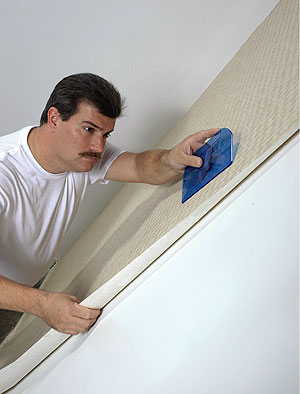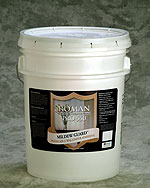|

Wallpaper Adhesives
Adhesives can vary distinctly in their physical and performance properties, specifically to solids content, viscosity, level of wet tack, open time, strippability and compatibility with paste machines.
by Susan Brimo-Cox
When I was a youngster (more years ago than I want to admit), his main tool of the trade was a paste brush. My. how things have changed since then.
Today you would be hard-pressed to even find a paste brush. What I think would amaze him most, if he were still alive, would be the variety of wallpaper adhesives available these days.
Of course, more products means more choices. Some contractors try to eliminate some of the confusion by living by the one-product-works-for-everything rule. How unfortunate for them.
The opposite approach would serve them better, observes Jim Turner, president of Regency Wallcraft Inc. "Any well-armed paperhanger will have a good assortment of adhesives if they want their life to be easy and simple," he says.
Simply put, different types of wallpaper adhesives have different characteristics that make them ideal for specific purposes. Depending on whom you talk to, wallpaper adhesives can be categorized many ways, but they generally are grouped as clear adhesives, clay adhesives and specialty adhesives.

Most wallpaper adhesives are starch-based, and they are designed to provide a mechanical bond between the wallcovering and the substrate. That is pretty much where the similarity ends.
Adhesives can vary distinctly in their physical and performance properties, explains Linda Mitchell, senior brand manager of wallcovering products for Zinsser Co. Inc., who points specifically to solids content, viscosity, level of wet tack, open time, strippability and compatibility with paste machines.
For the uninitiated, solids content has to do with the amount of water or moisture in the adhesive. Moisture content affects many of the other properties of adhesives. For example, less moisture means more wet tack — greater stickiness. On the other hand, more moisture usually means more open time. The amount of moisture also affects the viscosity, which has to do with how it flows in a paste machine or how stiff it is to roll.
Strippability is a separate characteristic that has everything to do with a specific adhesive's formulation. If you want it, make sure the product says it is strippable on the label.
Commercial paperhangers are the primary market for clear adhesives, which came on the market in the 1980s and which perform ideally with commercial wall materials. Clears are also used occasionally in residential applications.
The solids content of clear adhesives can range from 15 percent to 35 percent, depending on the formula. As compared to clay adhesives, clears have more open time. And many clear ready-mixes are compatible with pasting machines.
Clay adhesives were developed for the heavy vinyl wallcoverings common in commercial applications — you'll almost never see clay adhesives used in residential applications. The solids content of clay adhesives ranges from 35 percent to 50 percent, which is perfect for low-moisture materials. And they definitely have more stick than clears, as a rule, but the clay can cause staining. Still, if you need an adhesive that dries fast, clays are the ticket.
The closest thing you're likely find to a one-product-fits-all adhesive is among the clears. Many manufacturers have developed formulas that are designed for a wide range of wallcovering materials. In fact, says Jerry Russo, president and CEO of Roman Decorating Products Inc., the increased wet-tack characteristic of clays was truer 10 years ago. Today, he explains, "technology enhancements have produced clear adhesives with similar characteristics."
There are several kinds of specialty adhesives, but two predominate: vinyl-over-vinyl and pre-pasted activators.
Vinyl-over-vinyl adhesives are problem-evaders. The acrylic or co-polymer additives in these adhesives will bond to just about anything. Say you have a wall already covered with a vinyl material, and the vinyl can't be stripped without causing a lot of damage to the wall. Vinyl-over-vinyl adhesive allows you to adhere one vinyl material on top of another.
Vinyl-over-vinyl adhesive is also often available as border or border-and-seam adhesive.
Eventually, however, you will have to address the root problem. Frank Nicholson, western regional sales manager with Gardner-Gibson, says that vinyl-over-vinyl adhesives are not strippable. At some point all the layers will have to be removed and the underlying problem corrected.
Another problem with the vinyl-over-vinyl solution is that when you apply a second layer of material you lose your Class-A fire rating. Russo explains that the second layer of vinyl delaminates from the first layer and, as a result, it burns and flashes.
Pre-pasted activators were designed to use with pre-pasted papers and pre-pasted paper borders typically used in residential applications. As a rule, Nicholson reports, pre-pasted papers have a weaker bond than papers you paste up with ready-mix. And simply soaking pre-pasted papers in a water box dissolves some of the adhesive. To correct the problem, he says, contractors began diluting clear adhesive, but to be effective the ready-mix needs to be diluted a minimum of 50 percent, and therein lay a few other problems: Either you think adding 25 percent water makes it thin enough, but it's not, or you add 50 percent water and you have a runny mess to try to apply.
Activators are a user-friendly solution. Nicholson explains they are a "high-water content, ready-to-use product that adds more solids for better adhesion and enough water for the material's needs." The high-moisture content allows the paper to relax, but, because you are not soaking the pre-pasted product in a water box, the built-in adhesive does not dissolve.
I would be remiss if I didn't mention powder adhesives, the adhesives of my grandfather's day. You need to mix these products yourself. They are the traditional starch-based wallpaper adhesives made using wheat paste, cellulose, potato, tapioca or other starches. The solids content is very low — 3 percent to 10 percent — and the bond is less aggressive, which was fine when wallpapers were all paper. Today, this limits their use, but they are still good for English papers that need moisture to totally relax and conform to the wall.
Some contractors routinely keep some powders on hand. Powders can be kept in the truck without worry about freezing temperatures and may save the day if you run out of your regular adhesive. However, since there really isn't much call for powders anymore, some manufacturers have discontinued them.
"Every adhesive has its use," says Chris Murphy of Chris R. Murphy, Paperhanger Ltd., "but sometimes it's a challenge to find the right paste." The first place to start is with the wallcovering, he says.
Mitchell says it is important to consider the backing material as well as the face material. For example, she says, woven or fabric-backed products commonly used in commercial applications typically dictate a strippable, heavy-duty clear adhesive, though some contractors will use a strippable clay adhesive.
Nonwoven-backed products need a heavy-duty clear, with some recommended to be hung with a clay adhesive. If you're hanging wood veneer, you definitely need a heavier paste. Generally speaking, "The heavier the wall covering, the more solids and wet tack you want," Mitchell says.
On the other hand, delicate papers require a delicate paste, some with a lot of moisture, but you'll want to avoid moisture with papers that have a watercolor-printed surface.
For commercial contractors, an adhesive's compatibility with paste machines is often important. Again, choose a product wisely, advises Mitchell. For example, she says, if you decide to use a clay adhesive designed for low-moisture materials but have to add water to get it to flow in the paste machine you're at odds with your purpose. By adding water you're more likely to have installation problems.
Heavy-duty adhesives are typically manually applied with a roller rather than a paste machine. You might also consider a roller if you are installing an inflexible wall covering.
If later removal is important, chose a strippable adhesive. As Turner explains, "At the end of the install I want the job to look right, and later I want to be able to remove it without any wall damage. The weakest area between the drywall and the wallcovering is meant to be the adhesive in a strippable paste."
Even if you choose the ideal adhesive for the wallcovering you're working with, if the wall prep wasn't done correctly you could be in trouble. As Nicholson points out, "Wall preparation is still 95 percent of the job. Very seldom is the problem the adhesive or the wall covering."
Good wall preparation requires that new drywall be properly primed. Existing walls that may be peeling or blistering need to be scraped and re-primed, or sealed and a liner applied. "If you have an unstable [substrate] anything you do on top of it is a crap shoot," Murphy says.
Another issue that may come up, particularly if you work in the commercial arena, is mold and mildew. As in other segments of the construction industry, the wallpaper adhesive industry is responding to mold concerns. While wallcovering may be getting part of the blame, it's really moisture with the right environmental conditions — such as the right climate and a food source — that causes mold and mildew to grow.
Nonetheless, several adhesive manufacturers have developed systems that include enhanced mildewcides. One system, a combination of primer and adhesive products that work in tandem, has a five-year warranty. Other systems are combinations of permeable primers and adhesives. Some experts, however, suggest caution in turning to these kinds of products as cure-alls.
"New paperhangers are generally worried about the wallcovering falling down, so adhesive selection is often based on overkill," Turner observes. But he says contractors shouldn't be guided by their worst fears.
Even the old pros may need to take a new look at what's available. As Mitchell points out, "The technology of adhesives has changed so much they should be open-minded to try some of the new products."
Not sure about something new? Read the directions and test it. And then talk to the manufacturer about your results. Russo says, "Whenever a manufacturer changes something, they want to know if it works, and if there are any unexpected issues that crop up. We need to talk with paperhangers to find those things out."
In a business where minimum paste is the best policy, you may be surprised to discover better pastes that result in superior installations. And where you are typically at the mercy of the wallcovering specifier, being well-armed is just good business. I'm sure my grandfather would agree.

|

